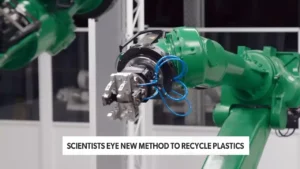
A New Plastic Recycling Method
min read
Christina Thompson (Anchor, EarthxNews): Have you heard the term “microfactories?”
Researchers are testing out a new concept that could create a more sustainable process for recycling plastics. The potential solution is microfactories. And in Arizona, city leaders in Phoenix and scientists at Arizona State University are teaming up to explore how this type of facility could impact the industry, particularly when it comes to uniquely shaped products that the public doesn’t typically recycle—like a child’s old car booster seat or broken toys.
Joining us now to discuss is Alicia Marseille, senior director at Arizona State University. Alicia, welcome on!
MARSEILLE: Thank you. Thank you for having me.
THOMPSON: So what exactly is a microfactory?
MARSEILLE: That’s a great question. And our efforts are a multi-stakeholder, multi-partnership project where we are looking at transforming the entire system. And so we’re working with City of Phoenix as well as Goodwill of Central and Northern Arizona and a community economic development organization to transform the value chain and how we collect, process, and convert recycled plastics into new products. And so we—in this microfactory—are the first to combine material recovery with remanufacturing and create a closed-loop system here in our region.
THOMPSON: So when it comes to recycling these plastics, how much actually gets recycled?
MARSEILLE: Currently, less than 9% of plastic in the US is recycled!
THOMPSON: Wow, that is far lower than I would have thought and I think a lot of our viewers would have thought. How does that compare to other recycling rates for items like paper and glass?
MARSEILLE: Glass is much higher. With plastic, there are nuances, right, because every region recycles and has different recycling options available. Our goal is to localize, create a hyper-local system for material recovery. We’re starting with plastics and we’re going to actually look at additional materials. But how do we create a hub and spoke model where materials can actually be recovered and remanufactured and keep the jobs local? So, instead of shipping materials overseas and the jobs overseas how do we keep them local and create the opportunities here in our region.
THOMPSON: Why do you think there is a disparity?
MARSEILLE: Oh, that’s a great question! Quite complex if you will, but I think part of it is, you know, how do we rethink consumer education and that it’s not actually waste material. Plastic is actually a very valuable, pretty amazing material, so we actually collect more. How do we get it, keep it in the system longer… that’s the goal of circular economy—to extend the life cycle of the product. And something that we talk a lot about through our hubs is how do we bring what’s considered “back of house” in terms of this type of processing front of house, so people can actually see their recycled materials going in one end and end products coming out the other. So they’re able to see the value of of changing their behavior locally.
THOMPSON: So with these microfactories, I know we brought up the example of perhaps a child’s car booster seat, but what other types of items would you see getting recycled that would typically just end up in a landfill somewhere?
MARSEILLE: Yep, so we’re starting with, if you look at the bottom of a lot of your plastic goods number 2’s and number 5’s. So the rigid plastics: cell phone cases, like, the multitude of materials and products are actually endless. Part of the challenge will be—and what we’ve started discovering with Goodwill—is that they’re not all labeled, right? So a lot of the products that we’re recycling don’t have the triangle at the bottom. So we’ve invested in some technologies to sort and grade appropriately, to understand the the material properties. So we can increase the collections and then drive the consumer education to increase those collections by materials and products.
THOMPSON: Alicia Marseille, Thank you.
